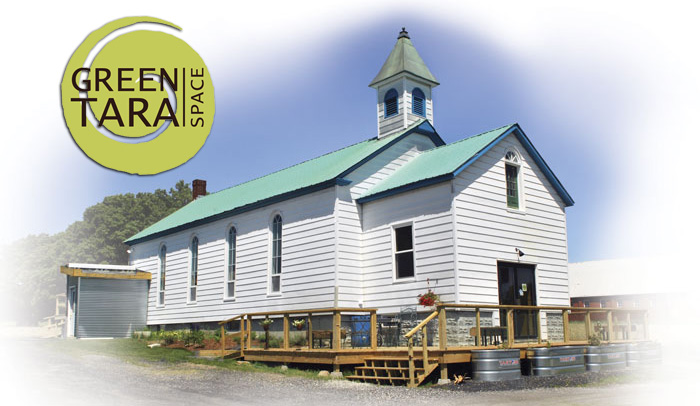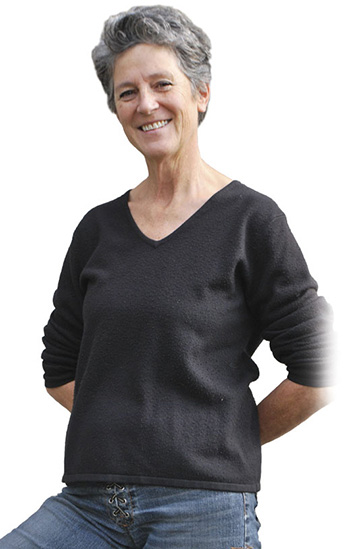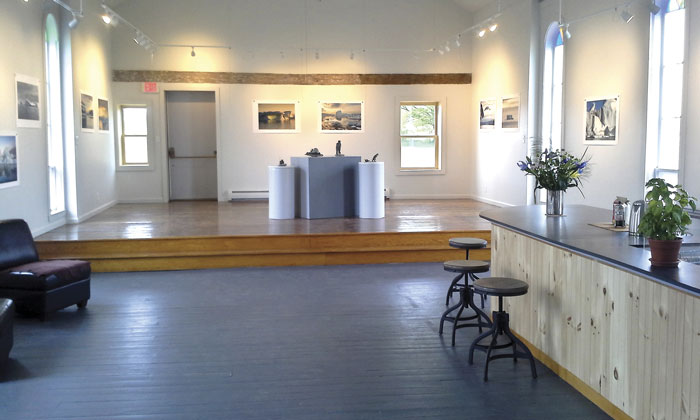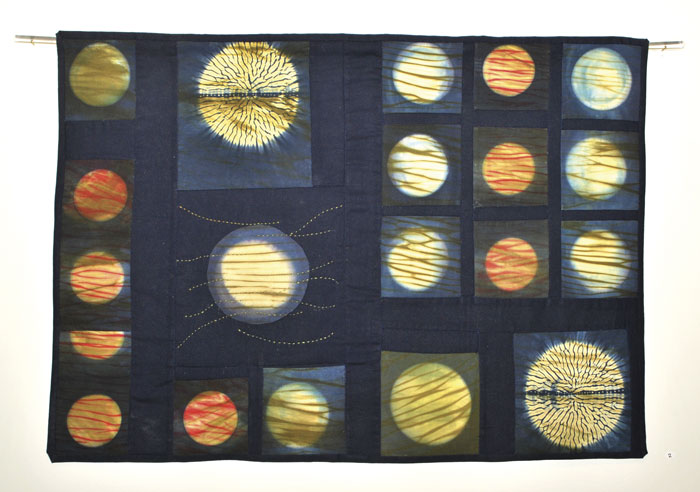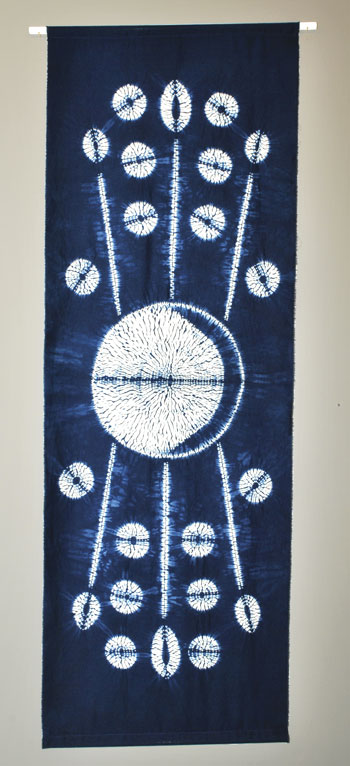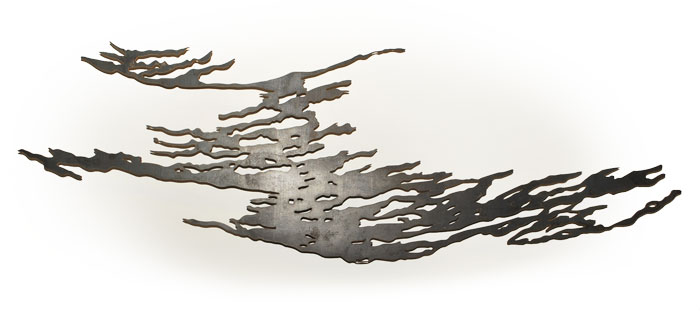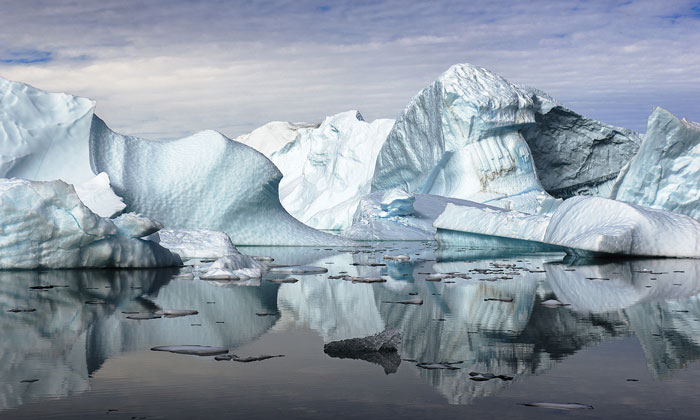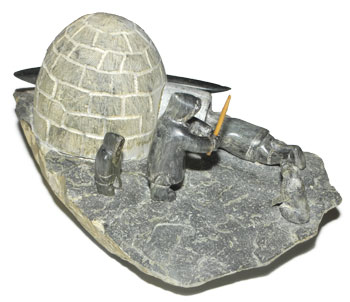| GreenTARA Space: A New Home for Art and Community | ||||||||||
| by Cynthia Close | ||||||||||
GreenTARA Space, a recently renovated Catholic church in North Hero now housing a gallery,café,and studios. |
||||||||||
The warm spring sun was low in the sky on the late afternoon of May 12, 2017, as Diane Gayer stood on the front deck of GreenTARA Space, a gallery housed in a renovated church. She was busy welcoming guests to the opening exhibition of this newest addition to northern Vermont's art and culture scene, located on Route 2 in Grand Isle. The atmosphere was celebratory at this long-anticipated event: over the course of the past year, word had gotten out among local artists that this former Catholic church would soon be transformed into a home for art, contemplation, and community. As the guests admired the elegant and dramatic photographs of icebergs and receding glaciers by Sarah Holbrook and the soapstone carvings depicting Inuit life by Emil Socher, they also took note of the sensitively handled renovation of the interior space of the church. A trained architect, Gayer was the driving force behind this project from the very beginning, and she will be the curatorial voice and programmer for the gallery in the foreseeable future. While Gayer has had a very active career over the past 30 years in Vermont as a teacher, adjunct lecturer at UVM, and architect in the Vermont Design Institute, she is also a citizen of the world. Her father was a diplomat. She attended French-speaking schools and was raised in Geneva until the age of 14. Unsurprisingly, she was an avid skier, having access to the mountains first in Switzerland then in Colorado, where she graduated from the University of Colorado, Boulder, in 1975 with a BA in German languages and later in 1979 with a master's in architecture from the University of Colorado, Denver. Gayer has received numerous grants on behalf of the Vermont Design Institute from the American Architectural Foundation Accent on Architecture awards program and ongoing support from the Vermont Arts Council. |
Diane Gayer,owner and director of GreenTARA. |
|||||||||
Gayer's working life parallels her personal life, and the common denominator has always been "renovation." In Colorado in the 1980s she owned and renovated a building that helped to turn around a section of town that was sliding into decline. When she applied for a job at UVM in the architect's office, she ultimately found herself responsible for the complete renovation of the Old Mill, a prominently situated building in the heart of the UVM campus, a project that took three years to complete. In 2000 Gayer moved to Burlington from Hinesburg. During this time she was also looking for a vacation camp, and she along with a group of 10 other women bought the collection of motel cabins and other structures known as Birdland in North Hero on the shores of Lake Champlain. In traveling back and forth between her home in Burlington to summers in North Hero, she noticed a Catholic church—classic New England style, with white clapboards and a steeple—that was slowly falling into disrepair. Upon further investigation she discovered it had been on the market for the past 10 years and no one seemed interested in buying it.
Originally the building had been constructed in 1823 at another Vermont location as a general store. In 1888 it was reconfigured as a church and moved on rollers to its current, highly visible spot on Route 2 in North Hero, where it became an active part of the town's religious community for the next 120 years. Although the building had hosted arts-and-crafts activities during the summers, after it stopped operating as a church, it was still owned by the Catholic Archdiocese. The fact that the structure had been neglected and was slowly crumbling was not a deterrent for Gayer. It was the location of the building, situated close to the center of the village making it accessible and integral to the life of the community, that most attracted her. She kept an eye on the property and watched as the asking price gradually came down from a high of $325,000 to what was more affordable from Gayer's point of view, considering the investment necessary to bring the place up to code and turn it into the artistic and creative hub she envisioned. Ultimately, Gayer negotiated a mutually agreeable price and bought the church. Then the hard work of cleaning out the space, which had become a home for bats among other things, began in earnest. Utilizing local construction expertise was important in the process of transforming the church into an exhibition space and café, with studios in the basement for rent. Building community is part of Gayer's worldview, using the resources that already exist within neighborhoods to improve those same neighborhoods as opposed to development coming in from outside and imposing an inappropriate solution.
Gayer's spiritual leanings are apparent in the name she chose for the gallery. Tara in Tibetan Buddhism is a female bodhisattva, a realized being who has reach nirvana but remains on Earth to save others. A tantric meditation deity, Tara is used to understand the outer, inner, and secret teachings about compassion and emptiness. Green Tara, a form of Tara (there are eight variants of Tara), is known as the Buddha of enlightened activity. Gayer hopes that creating this space with those qualities in mind will foster positive energy that will grow over time. The fact that Gayer is a competent businessperson as well as an artist in her own right is not a contradiction. No artistic or creative endeavor at this level can survive unless it includes a sound business plan. Although GreenTARA is well positioned to draw in a large crowd of summer folk traveling north to the islands or coming down from the border of our northern Canadian neighbor, Quebec, summers in Vermont are not that long. Beyond the leaf-peeping months of September and October, how does Gayer plan to sustain GreenTARA? To address that question, Gayer has renovated the large, open basement area, which she intends to rent out to working artists and researchers. These spaces are available at reasonable rates and provide collaborative working environments with shared utilities. On the gallery website you can find a photo of the space and contact information if you are interested in a year-round or seasonal workspace. The main gallery opens up onto idyllic vistas, has a beautiful front deck, and is suitable for event rentals. What better place for a wedding than on this formerly hallowed ground, surrounded by art and good vibes? When asked about her winter exhibition schedule, Gayer demurred; she will take stock of where things are in the fall. But her eyes lit up as she ran through the list of exhibitions already planned and her final tantalizing words were "I have things in mind."
|
||||||||||
|
Cynthia Close is a contributing editor for Documentary Magazine, art editor for the literary journal Mud Season Review, and an advisor to the Vermont International Film Festival. She lives in Burlington, Vermont.
|
|||||||||
